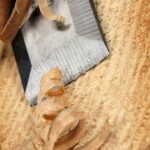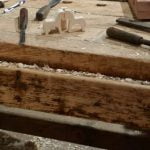Lead paint was commonly used in homes before its ban in 1978, and many older houses still have layers of this hazardous material on their woodwork. Over time, this lead paint can crack and deteriorate, posing significant health risks to those living in the space. In this article, we will address the question of what to do with woodwork lead paint that is cracking.
Cracking lead paint not only diminishes the aesthetic appeal of your woodwork but also exposes you and your family to lead poisoning. Lead is a potent neurotoxin that can have severe consequences on human health, particularly for children and pregnant women. When lead paint begins to crack, it releases dust particles and chips that can be ingested or inhaled, leading to lead poisoning.
Understanding the dangers associated with cracking lead paint is crucial for homeowners who are living in older houses or considering purchasing one. It is essential to be vigilant and take necessary precautions when dealing with these situations.
This article provides a comprehensive guide on how to identify the presence of lead paint on your woodwork, evaluate its severity, implement temporary safety measures, safely remove the cracked paint, repair and restore the woodwork, dispose of contaminated materials responsibly, prevent future issues, and know when professional assistance may be needed.
By following the information provided in this article, you will gain valuable knowledge about dealing with cracking lead paint on woodwork. Taking proactive steps to mitigate the risks associated with this hazardous material is essential for maintaining a safe and healthy living environment for yourself and your loved ones.
Identifying the presence of lead paint on your woodwork
Lead paint poses serious health risks, especially when it begins to crack on woodwork. To ensure the safety of yourself and your family, it is important to be able to identify the presence of lead paint on your woodwork. This section will discuss the signs that indicate the presence of lead paint, testing methods to confirm its presence, and safety precautions to take when dealing with lead paint.
Signs of lead paint on woodwork may include its characteristic color, which is often a dull grayish blue or a creamy yellow. Lead paint may also have a distinct sweet smell. However, these visual and olfactory cues are not always reliable indicators, especially if the woodwork has been painted over in subsequent years. Therefore, it is recommended to conduct a test for lead content.
There are various testing methods available for determining the presence of lead in paint. One common method is using a commercially available lead test kit, which typically provides results within minutes. Another option is sending samples of the paint to a laboratory for analysis. It is important to follow safety precautions during testing to avoid exposure to lead dust or particles. These precautions may include wearing gloves, goggles, and a respirator mask.
| Signs of Lead Paint | Testing Methods | Safety Precautions |
|---|---|---|
| – Dull grayish blue or creamy yellow color | – Commercially available lead test kit | – Wear gloves, goggles, and respirator mask during testing |
| – Sweet smell | – Send samples to a laboratory for analysis | – Avoid disturbing the painted surface unnecessarily |
Once you have confirmed the presence of lead paint on your woodwork, it is crucial to take safety precautions when dealing with it. It is important to avoid disturbing the painted surface unnecessarily to prevent the release of lead dust or particles into the air. If you plan to clean or renovate a surface with lead paint, it is advisable to hire a professional trained in lead-safe work practices.
In addition, if you have young children or pregnant women living in your home, it is recommended to create a safe and separate living area during any renovations involving lead paint. This will minimize their risk of exposure to lead dust and ensure their health and well-being.
By properly identifying the presence of lead paint on your woodwork and taking necessary precautions, you can effectively protect yourself and your loved ones from the dangers associated with cracked lead paint. In the next section, we will discuss how to evaluate the extent of cracking lead paint and assess potential risks for further action.
Evaluating the extent of cracking lead paint
Assessing the severity and potential risks of cracking lead paint on woodwork is an important step in effectively addressing this issue. By evaluating the extent of the damage, homeowners can determine the appropriate course of action to mitigate any potential health risks.
To begin evaluating the situation, it is crucial to thoroughly inspect the affected areas for signs of cracking lead paint. Look for blistering, peeling, or chipping paint that exposes bare wood beneath it. It is also important to consider factors such as the age of the paint and the condition of the underlying woodwork.
Once you have identified the presence of cracked lead paint, it is essential to understand the potential risks associated with it. Lead is a toxic substance that can be harmful if ingested or inhaled, especially for children and pregnant women. The primary concern with cracked lead paint is that it can create dust particles containing lead which can easily be unknowingly ingested or inhaled. If these particles accumulate over time, they can pose a serious health risk.
In order to properly assess the severity of cracking lead paint and potential risks, homeowners may consider conducting a professional lead test or utilizing DIY test kits that are available in most hardware stores. These tests can confirm whether or not the paint contains hazardous levels of lead, providing valuable information for determining next steps in addressing this issue.
Data
| Severity Level | Risk Level |
|---|---|
| Mild | Low |
| Moderate | Moderate |
| Severe | High |
Based on your evaluation, you can determine the severity level of the cracked lead paint and the associated risk level. It is important to understand that even mild cases of cracking lead paint should not be ignored, as any amount of lead exposure can have potential health consequences. However, higher severity levels indicate a more urgent need for remediation to prevent further damage and minimize health risks.
Taking the time to properly assess the severity and potential risks of cracked lead paint on woodwork will ensure that homeowners are equipped with the necessary information to make informed decisions about how to address this issue. Whether through DIY methods or by seeking professional assistance, it is crucial to prioritize safety and take appropriate action in order to create a healthier living environment for yourself and your family.
Temporary solutions for immediate safety
Cracking lead paint on woodwork can pose serious health risks, especially if it releases lead particles into the air or onto surfaces that come into contact with people. While permanent removal and restoration of the affected woodwork is necessary, there are immediate temporary solutions that can be implemented to reduce the risks of lead exposure. These protective measures can mitigate the dangers until a more thorough approach can be taken.
One temporary solution is encapsulation, which involves sealing off the cracked lead paint to prevent further deterioration and release of lead dust. This can be done by applying a specialized encapsulating primer or coating over the affected areas. The encapsulant forms a barrier between the paint and the environment, effectively containing any potential lead hazards. When using an encapsulant, it is important to follow the instructions provided by the manufacturer and ensure proper ventilation during application.
Another option is covering the cracked lead paint with a temporary barrier such as plastic sheeting or adhesive-backed film. This physical barrier acts as a protective layer preventing direct contact with the lead paint and reducing the risk of inhalation or ingestion of lead particles. However, it is important to regularly check and replace these barriers as they may deteriorate over time or become damaged.
In addition to encapsulation and covering, practicing good housekeeping can also help minimize exposure to cracking lead paint on woodwork. Regularly clean surfaces by using wet methods such as damp mopping or wiping instead of dry sweeping, which can stir up dust particles. It is advisable to use HEPA-filtered vacuum cleaners specifically designed for removing lead dust without spreading it further.
Implementing these temporary solutions provides immediate safety measures against potential lead exposure from cracking painted woodwork. However, it is essential to note that these measures only offer temporary relief and should not replace permanent removal and restoration actions. Taking prompt steps towards addressing cracked lead paint on woodwork will contribute to creating a healthier living environment for you and your family.
Removing the cracked lead paint safely
When it comes to handling cracked lead paint on woodwork, it is of utmost importance to take the necessary precautions for safe removal. By following a step-by-step guide, you can ensure that the process is carried out effectively and with minimal risk of lead exposure. Here is a comprehensive guide on how to safely remove cracked lead paint from your woodwork:
- Prepare the area: Before starting the removal process, make sure to prepare the area properly. Remove any furniture or objects that may obstruct your work and cover surrounding surfaces and floors with plastic sheets or drop cloths to catch any dust or debris.
- Safety gear: It is crucial to wear appropriate safety gear during lead paint removal. This includes a respirator fitted with HEPA filters, goggles or safety glasses, disposable gloves, and coveralls or protective clothing that can be easily removed and washed separately from other garments.
- Wet method: To minimize the release of lead dust and debris into the air, it is recommended to use the wet method for removal. Begin by misting the cracked paint surface with water using a spray bottle or garden sprayer. This helps suppress dust particles and prevents them from becoming airborne.
- Scrape off loose paint: Using a putty knife or scraper, gently remove any loose or peeling paint from the surface. Collect all scraped-off materials in plastic bags immediately after removing them from the woodwork.
- Contain and dispose of waste: To prevent further spread of lead-contaminated materials, double-bag all waste generated during the removal process in heavy-duty plastic bags labeled as hazardous waste. Store these bags in a secure location away from children and pets until they can be disposed of properly according to local regulations.
- Cleaning up: Thoroughly clean all surfaces in the work area after removing cracked lead paint. Use a HEPA vacuum to carefully remove all dust and debris, ensuring that every corner and crevice is meticulously cleaned. Then, wash the area with warm water and a mild detergent to eliminate any residual lead particles.
Remember, safely removing cracked lead paint is essential to minimize the risk of lead exposure. It is highly recommended to follow these step-by-step instructions and adhere to local regulations regarding the handling and disposal of lead-contaminated materials. If you are unsure or uncomfortable carrying out this process yourself, it is always best to seek professional assistance for reliable and safe lead paint removal.
Repairing and restoring the woodwork
Repairing and restoring woodwork that has been damaged by cracked lead paint is essential not only for the aesthetic appeal of your home but also for the safety and health of its occupants. Cracked lead paint can expose individuals to harmful lead dust and chips, which can be especially dangerous, particularly for children. Therefore, it is crucial to address the damage caused by cracked lead paint properly and promptly.
One technique to address the damage caused by cracked lead paint on woodwork is through thorough preparation before applying new paint. Start by removing any loose or peeling paint using a scraper or putty knife. It is imperative to wear protective clothing, gloves, and a NIOSH-approved respirator mask when working with lead paint to minimize exposure.
After the loose paint has been removed, sanding the surface may be necessary to create a smooth and even base for repainting. However, it’s crucial to remember that sanding can generate lead dust particles, so using wet sanding or employing methods that minimize airborne dust is recommended. Once the surface has been sanded, wipe it down with a damp cloth or use a HEPA vacuum cleaner to remove any remaining dust.
Before applying new paint or primer, it may be necessary to fill in any cracks or holes in the woodwork. Use an appropriate wood filler that adheres well and is non-toxic. Once filled, allow sufficient time for the filler to dry completely before proceeding with painting.
When applying new paint or primer over repaired woodwork, choose high-quality products specifically designed for covering surfaces where lead paint was present. These products have excellent adhesion properties and are formulated with low levels of volatile organic compounds (VOCs). Apply multiple thin coats rather than one thick coat for better durability and coverage.
By utilizing these techniques and following proper safety precautions during repair and restoration work, you can effectively address the damage caused by cracked lead paint on woodwork while ensuring minimal exposure to potentially harmful lead particles. Taking these necessary steps will contribute to a healthier living environment for you and your loved ones.
Proper disposal of lead-contaminated materials
When dealing with cracked lead paint on woodwork, it is essential to handle the resulting lead-contaminated materials with care and dispose of them properly. Improper disposal can pose serious health risks to both humans and the environment. In this section, we will discuss eco-friendly and responsible ways to manage lead waste, ensuring that you are taking the necessary precautions for a safer living environment.
Understanding the risks
Before diving into proper disposal methods, it is crucial to understand the potential hazards associated with lead-contaminated materials. Lead is a toxic substance that can cause various health problems, especially when ingested or inhaled. It can harm multiple organs such as the nervous system, kidneys, and reproductive system. In addition, improper disposal of lead waste can contaminate soil and water sources, posing further risks to wildlife and ecosystems.
Using certified hazardous waste facilities
One of the most environmentally friendly ways to dispose of lead-contaminated materials is by utilizing certified hazardous waste facilities. These facilities are equipped to handle hazardous substances safely and are authorized by local authorities for proper disposal.
When considering disposing of lead paint chips or other contaminated materials, contact your local environmental agency or waste management authority for information on certified facilities in your area. These facilities often have specific guidelines for packaging and transporting hazardous waste, so be sure to follow their instructions closely.
Sealing and securing waste
When managing lead-contaminated materials before disposal, it is vital to prevent any further release of lead particles or dust into the environment. To do this effectively, seal all waste in plastic bags or containers designed for hazardous materials. This prevents any potential spread during transportation or handling at certified facilities. Furthermore, consider using duct tape or plastic sheeting to secure any loose sections that may detach during transit.
By ensuring the proper disposal of lead-contaminated materials, you are minimizing the risks associated with lead exposure and contributing to a healthier environment. The next section will discuss tips for maintaining and preventing further cracking on woodwork, helping you avoid future lead paint issues.
Preventing future lead paint issues
Regular inspection and maintenance
One of the key ways to prevent future lead paint issues and minimize the risk of cracking on woodwork is through regular inspection and maintenance. Take the time to examine your woodwork for any signs of peeling, chipping, or cracking paint.
If you notice any areas that are starting to deteriorate, it’s important to address them promptly before they worsen. Regularly inspecting and maintaining your woodwork will help you catch any potential lead paint issues early on and prevent further cracking.
Implementing proper cleaning techniques
Another important step in preventing future lead paint issues is by implementing proper cleaning techniques on your woodwork. When cleaning surfaces with lead paint, it’s crucial to avoid methods that can potentially release lead particles into the air or spread them onto other surfaces.
Instead, opt for damp wiping or HEPA vacuuming methods that capture dust and debris effectively without spreading contaminants. Regularly removing dust and debris from your woodwork will help maintain its integrity and reduce the risk of cracking.
Applying protective coatings
To further protect your woodwork from cracking lead paint, consider applying a protective coating over the painted surface. This can act as a barrier between the lead paint and the surrounding environment, reducing the risk of exposure and preventing further deterioration.
Before applying a protective coating, it’s important to properly prepare the surface by cleaning it thoroughly and making any necessary repairs. Additionally, choose a non-toxic coating that is specifically designed for use on surfaces with lead paint to ensure maximum effectiveness.
By implementing these preventive measures, you can significantly reduce the likelihood of future cracking on your woodwork due to lead paint. However, it is important to keep in mind that prevention is not always foolproof, especially if you have older homes with multiple layers of lead paint. In such cases, seeking professional assistance may be necessary to ensure the safety and well-being of yourself and your family.
Seeking professional assistance
While there are temporary measures and DIY techniques that can be employed to mitigate the risks associated with cracked lead paint on woodwork, there are instances where it is crucial to seek the expertise of a lead paint removal specialist. These professionals have the necessary training, knowledge, and tools to safely remove and dispose of lead-contaminated materials, ensuring the health and safety of everyone involved.
One important factor to consider when deciding whether or not to hire a lead paint removal specialist is the extent of the cracking lead paint and potential risks. If the cracking is widespread and severe, or if there is evidence that children or pregnant women have been exposed to the lead dust, it is highly recommended to consult with an expert. They will be able to assess the situation thoroughly and determine the most appropriate course of action.
Additionally, hiring a professional may be necessary if you are unsure if your woodwork contains lead paint. Even with testing kits available for homeowners, accurate identification can be challenging without proper training and experience. A lead paint removal specialist can conduct comprehensive testing using specialized equipment and protocols to confirm the presence of lead paint accurately.
Another scenario that warrants seeking professional help is when dealing with large-scale projects or intricate woodwork. Removing cracked lead paint from intricate carvings or delicate surfaces requires precision and expertise to avoid causing additional damage. Professionals will have experience in handling such situations and possess the necessary skills to handle these delicate surfaces without compromising their integrity.
Conclusion
In conclusion, it is crucial to address cracked lead paint on woodwork in order to create a safe and healthy living environment. The dangers of lead exposure cannot be underestimated, especially for young children and pregnant women. By following the steps outlined in this article, homeowners can effectively manage the presence of lead paint and minimize the risks associated with its cracking.
Firstly, it is important to properly identify the presence of lead paint through signs, testing, and taking necessary safety precautions. This will ensure that appropriate measures are taken to protect oneself and others from potential health hazards. Temporary solutions such as sealing or encapsulating the cracked paint can provide immediate safety while a more permanent solution is pursued.
When it comes to removing the cracked lead paint safely, it is essential to follow a step-by-step guide that includes proper containment, personal protective equipment, and disposal protocols. This will prevent the spread of lead dust particles and minimize any further contamination.
After addressing the cracked lead paint, repairing and restoring the woodwork is required to eliminate any aesthetic or structural damage caused by the cracking. Techniques such as sanding, repainting, or replacing damaged sections can help restore the woodwork’s original beauty and functionality.
Proper disposal of lead-contaminated materials is crucial for environmental preservation. Homeowners should ensure that they dispose of these materials responsibly by following eco-friendly guidelines or seeking assistance from specialized waste management facilities.
Finally, preventing future lead paint issues involves maintaining regular inspections on woodwork surfaces to identify any potential cracking or flaking before it becomes a larger problem. Taking proactive measures like proper cleaning methods and using non-toxic alternatives for painting can help preserve both the appearance and safety of woodwork in the long term.
In cases where homeowners may not have sufficient knowledge or resources to safely handle cracked lead paint on their own, seeking professional assistance from certified specialists in lead paint removal is recommended. These experts can provide thorough assessments, implement effective removal techniques while ensuring minimal disruption to the household.
By addressing and properly managing cracked lead paint on woodwork, homeowners can create a healthier living environment for themselves and their families. It is vital to prioritize safety and take necessary precautions when dealing with lead paint to protect against the harmful effects of lead exposure. With proper identification, removal, repair, disposal, and prevention strategies in place, homeowners can confidently maintain their woodwork’s integrity while minimizing health risks associated with cracked lead paint.
Frequently Asked Questions
Can I paint over cracked lead paint?
Painting over cracked lead paint is not recommended, as it can be hazardous to both your health and the environment. Lead in paint poses a serious risk, especially when it begins to deteriorate and create dust or chips.
It is crucial to address lead paint issues properly, which often involves professional abatement or remediation techniques following local regulations. Attempting to paint over cracked lead paint without proper precautions can release lead particles into the air or contaminate the soil, leading to potential health risks.
How do you seal cracked lead paint?
Sealing cracked lead paint is not an effective solution for dealing with this hazardous material. It is important to understand that sealing only covers up the issue temporarily, but does not eliminate the underlying problem of lead exposure.
The cracks on the surface of lead paint are indication of its deterioration, and simply sealing it will not address potential hazards associated with lead poisoning. Proper containment and removal measures should be taken by certified professionals trained in lead-safe practices, ensuring that all necessary protocols are followed.
Can you paint over cracked paint on wood?
Yes, you can certainly paint over cracked paint on wood surfaces. However, there are a few steps you should take before doing so to ensure a durable and attractive finish. First, you’ll need to prepare the surface by removing any loose or peeling paint using sandpaper or a scraper.
Then, clean the area with soap and water to remove dirt and debris. Next, apply a primer suitable for wood surfaces; this will help promote adhesion and provide an even base for your new coat of paint. Once the primer has dried completely as per manufacturer instructions, you can proceed with painting over the cracked areas using an appropriate wood-compatible paint type and color of your choice.

Hi everyone! I’m a woodworker and blogger, and this is my woodworking blog. In my blog, I share tips and tricks for woodworkers of all skill levels, as well as project ideas that you can try yourself.





